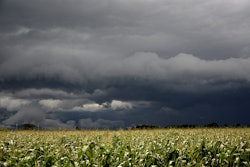This market scares me — truly scares me. The last time I sounded a widespread caution like this was early fall 1995 — that should tell you something. Bull markets come and go. Bear markets come and can drag on for years. Explosive markets come far less often but leave their mark for decades. The bull market that began in 2006 is one of those explosive markets that will impact the grain industry for a long time to come. Grain elevators have never needed so much money just to operate, and they now face potentially record contract risk on the staggering volume of forward purchases from farmers. The Hedge-to-Arrive financial crunch of 1995/96 is a distant second compared to the risks facing the grain industry in 2008.
The good news is that record crops give you record handling volume, demand for storage, and the growth in exports as well as domestic markets provides numerous marketing outlets. Volatility brings risk, but it also creates opportunities. The challenge is to survive the risks.
Are the bull markets over?
The global surge in commodity prices has widespread causes. It’s fueled by the massive inflow of investment money into commodities as an asset class. Analysts and the media are talking about 10- to 20-year bull markets, with continued inflation, for example. The global surge is also fed by the rising standard of living in the Asian/India sector and the rising demand for protein and vegetable oils. It’s fueled by the steady draw-down of global inventories of all major food/feedstuffs, despite rising acreage. It’s increased by efforts of numerous countries to hold down food prices artificially, which in turn sustains demand. It’s fueled by the weak U.S. dollar that gives overseas countries greater buying power. All things — good or bad — eventually come to an end. That might be starting now but there’s no guarantee, and it just doesn’t have that ‘feel’ yet. What might be worse is if a significant retreat occurs, taking corn down a dollar or so, and soybeans down $2 for example — just enough to cause everyone to assume the storm is past. Then another and potentially even bigger rally could occur. It’s already happened this year in wheat.
Canary in the coal mine?
The drought of 1988 threatened the ability of many grain firms to finance inventories and short hedges, but that bull market didn’t last long and mostly affected nearby futures. The bull market of 1995/96 caused July 96 corn futures soar to $5.00, but December 96 rarely exceeded $3.50. The HTA crisis of 95/96 was costly for our industry, but the largest losses were confined to a fairly small number of firms. This year is different and the grain industry could become the canary in the coal mine; an early warning system of broader concerns where hedging isn’t working the way the grain industry expects.
Hedging price risk using exchange-traded futures and options works for the grain industry because cash prices track reasonably closely with futures. Or they should. This parallel movement gives lenders confidence that losses (or gains) in futures will be nearly offset by an opposite movement in the price of the underlying collateral. It’s the main reason lenders will finance up to 100% of market moves against inventory hedges and up to 80% of market moves on hedges against forward contracts.
收敛,谷物和油籽another important aspect to hedging: convergence. This is where cash and futures prices come reasonably close to each other in the futures delivery month in the delivery market. This gives hedgers confidence that sharply discounted basis levels will eventually rise as supplies tighten or as the futures delivery month nears. Since 2006, however, as grain and oilseed futures have climbed steadily, cash and futures prices are not tracking as closely. Convergence is not occurring as dependably in wheat and sometimes in soybeans.
One misconception among many elevators is that there is a floor to the basis. But sellers cannot just sell futures and bring trucks or trains of grain to Illinois and deliver them at the futures price (perfect convergence). That leaves cash to seek its own level, which could be far below futures. Can we say with confidence that if some unknown event triggers $20 soybeans, cash prices will go along cent for cent?
When cash and futures don’t track well, and futures and cash don’t converge properly, hedging effectiveness is reduced. It doesn’t mean elevators won’t or can’t make money from basis change, it just means the changes may be less predictable and more a result of random events.
Overall risk to grain hedgers rises when there’s record financing demand, record prices, no floor to the basis and unprecedented demand from producers who want to forward-sell production as far out as 2010. If elevators should be unable to secure financing, and risks become too great, dramatic changes could result: consolidation for example.
Beware the black swan
纳西姆•塔勒布题为“2007年撰写了一本书Black Swan – The Impact of the Highly Improbable” that should be required reading for the grain industry. Taleb’s book leads off with “Before the discovery of Australia, people in the Old World were convinced that all swans were white...” But the fact that people hadn’t seen a black swan didn’t mean such swans didn’t exist. He then takes that logic and generalizes it to describe “Black Swans” as events with three main characteristics:
- it’s unexpected, largely unpredictable and inherently rare;
- it has a dramatic impact;
- we create explanations for it after the fact.
September 11, 2001 is a classic Black Swan. The Christmas Day tsunami was a Black Swan. The subprime-mortgage catastrophe is a Black Swan (although some would say that it was predictable). Could the next Black Swan involve the economic sector?
My fear is the grain industry is more vulnerable than ever to a Black Swan — or even a gray one. It could be something that sends prices soaring, or one that cuts markets off at the knees. Consider for a moment the impact on agricultural futures, cash prices, and global trade if any of the following dramatic events occur:
- crop failures or shortages in more than one major producing country;
- a deep, global recession that causes demand to plummet;
- a catastrophic geopolitical event, such as a nuclear event between India and Pakistan, a political overthrow in China or Saudi Arabian oil complexes are blown up and oil soars to $200;
- a meltdown in the global financial sector that causes credit to essentially dry up for all but the highest-rated borrowers.
Take heed
Your primary business responsibility is to survive. Profits and customer satisfaction come next. Think about the impact of dramatically higher prices on your business or of a sharp retreat. As an owner or manager, do what you need to in dramatic markets — even if it’s unprecedented and potentially unpopular.
- Assess your real cost of handling grain at record prices. (what’s the shrink on $13 beans?)
- Set margins and service fees based on real costs.
- Stay hedged — holding a sizable long price risk position carries its own risks.
- Monitor all open contracts regularly for purchases and sales. What if that locally-owned ethanol plant fails before this fall, or what if corn futures fall sharply and the ethanol plant tries to walk away from $5 corn purchases? What if that big farm customer with all those 2009 sales to you dies next year and his widow sells the farm?
- Consider caps on forward contract price risk That could include aggregate by crop year, by customer, or by some other measure.
- Set caps on basis positions (long or short)?
- Assess and limit the types of strategies you offer beyond the current crop year. Some firms won’t offer HTAs, while others won’t buy fixed-price grain, for example.
- Charge fees on forward contracts. It defrays part of your interest cost and shows more commitment by the seller for performance.
- Line up financing and alternative sources of working capital that will allow your business to handle ever higher futures prices.
I hope dramatically higher prices don’t happen; $13 soybeans, $5.50 corn and $10 wheat are enough of a challenge. But you never know what lies ahead.




















